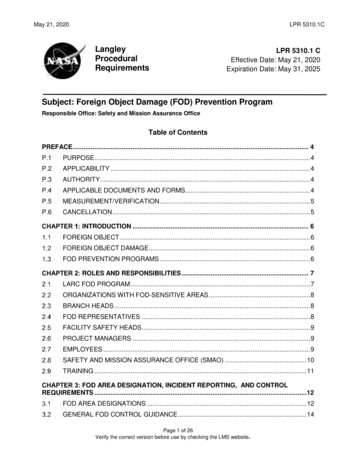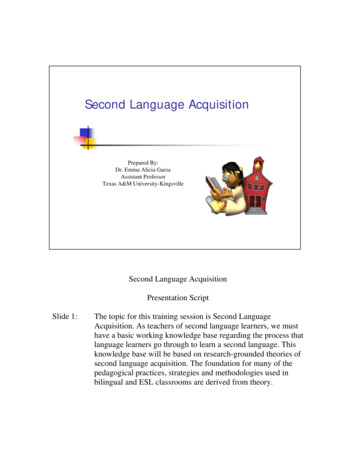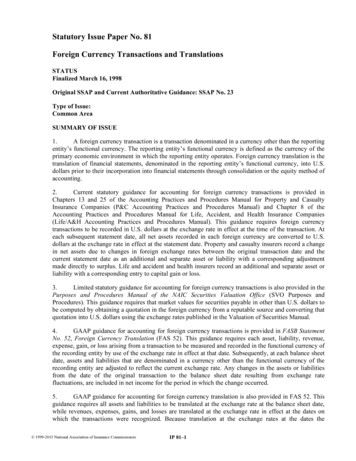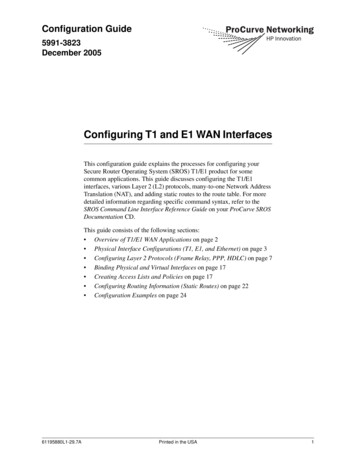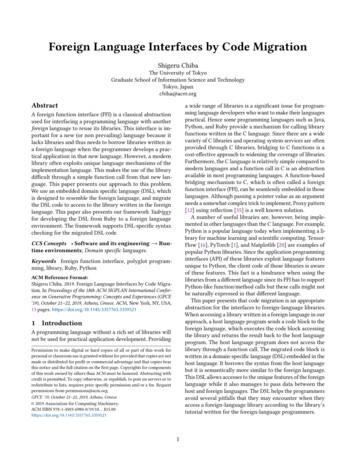
Transcription
Foreign Language Interfaces by Code MigrationShigeru ChibaThe University of TokyoGraduate School of Information Science and TechnologyTokyo, Japanchiba@acm.orgAbstracta wide range of libraries is a significant issue for programming language developers who want to make their languagespractical. Hence some programming languages such as Java,Python, and Ruby provide a mechanism for calling libraryfunctions written in the C language. Since there are a widevariety of C libraries and operating system services are oftenprovided through C libraries, bridging to C functions is acost-effective approach to widening the coverage of libraries.Furthermore, the C language is relatively simple compared tomodern languages and a function call in C is an abstractionavailable in most programming languages. A function-basedbridging mechanism to C, which is often called a foreignfunction interface (FFI), can be seamlessly embedded in thoselanguages. Although passing a pointer value as an argumentneeds a somewhat complex trick to implement, Proxy pattern[12] using reflection [35] is a well known solution.A number of useful libraries are, however, being implemented in other languages than the C language. For example,Python is a popular language today when implementing a library for machine learning and scientific computing. TensorFlow [16], PyTorch [1], and Matplotlib [20] are examples ofpopular Python libraries. Since the application programminginterfaces (API) of these libraries exploit language featuresunique to Python, the client code of those libraries is awareof these features. This fact is a hindrance when using thelibraries from a different language since its FFI has to supportPython-like function/method calls but these calls might notbe naturally expressed in that different language.This paper presents that code migration is an appropriateabstraction for the interfaces to foreign-language libraries.When accessing a library written in a foreign language in ourapproach, a host language program sends a code block to theforeign language, which executes the code block accessingthe library and returns the result back to the host languageprogram. The host language program does not access thelibrary through a function call. The migrated code block iswritten in a domain-specific language (DSL) embedded in thehost language. It borrows the syntax from the host languagebut it is semantically more similar to the foreign language.This DSL allows accesses to the unique features of the foreignlanguage while it also manages to pass data between thehost and foreign languages. The DSL helps the programmersavoid several pitfalls that they may encounter when theyaccess a foreign-language library according to the library’stutorial written for the foreign-language programmers.A foreign function interface (FFI) is a classical abstractionused for interfacing a programming language with anotherforeign language to reuse its libraries. This interface is important for a new (or non prevailing) language because itlacks libraries and thus needs to borrow libraries written ina foreign language when the programmer develops a practical application in that new language. However, a modernlibrary often exploits unique language mechanisms of theimplementation language. This makes the use of the librarydifficult through a simple function call from that new language. This paper presents our approach to this problem.We use an embedded domain specific language (DSL), whichis designed to resemble the foreign language, and migratethe DSL code to access to the library written in the foreignlanguage. This paper also presents our framework Yadriggyfor developing the DSL from Ruby to a foreign languageenvironment. The framework supports DSL-specific syntaxchecking for the migrated DSL code.CCS Concepts Software and its engineering Runtime environments; Domain specific languages.Keywords foreign function interface, polyglot programming, library, Ruby, PythonACM Reference Format:Shigeru Chiba. 2019. Foreign Language Interfaces by Code Migration. In Proceedings of the 18th ACM SIGPLAN International Conference on Generative Programming: Concepts and Experiences (GPCE’19), October 21–22, 2019, Athens, Greece. ACM, New York, NY, USA,13 pages. onA programming language without a rich set of libraries willnot be used for practical application development. ProvidingPermission to make digital or hard copies of all or part of this work forpersonal or classroom use is granted without fee provided that copies are notmade or distributed for profit or commercial advantage and that copies bearthis notice and the full citation on the first page. Copyrights for componentsof this work owned by others than ACM must be honored. Abstracting withcredit is permitted. To copy otherwise, or republish, to post on servers or toredistribute to lists, requires prior specific permission and/or a fee. Requestpermissions from permissions@acm.org.GPCE ’19, October 21–22, 2019, Athens, Greece 2019 Association for Computing Machinery.ACM ISBN 978-1-4503-6980-0/19/10. . . 15.00https://doi.org/10.1145/3357765.33595211
GPCE ’19, October 21–22, 2019, Athens, GreeceShigeru ChibaThe call to show on plt also results in the remote invocationof show. The code above is equivalent to this Python code:To explore this approach, we have developed Yadriggy 1 ,a framework in the Ruby language. It is used to implementan interfacing system from Ruby to the libraries written in aforeign language, such as Python. Our challenge is to realizethe approach without modifying Ruby or its programmingenvironment. With this aim, the framework assumes that thesyntax of the DSL is a subset of Ruby and only its semanticsis uniquely designed. The DSL will be regarded as a variantof Ruby extended with foreign-language features, in otherwords, as a language borrowing the syntax from Ruby butthe semantics from the foreign language. The frameworkprovides a facility for dynamically extracting an abstractsyntax tree (AST) for a code block given in the form of lambdaexpression or method object. The framework also providesa syntax checker to examine the extracted AST consists ofonly the selected syntactic forms for the DSL. It is a keycomponent to deal with a code block in a language withcomplex syntax like Ruby. The developer of the interfacingsystem would have to write tedious error-check code if thesyntax checker is not available. Restricting the availablesyntax in the DSL would also reduce the amount of work bythe developer. Furthermore, the syntax checker is used totag a particular shape of subtree of the AST. This tag can beused later, for example, during code generation.In the rest of this paper, Section 2 presents our motivatingexamples. Section 3 proposes our framework and Section 4shows how the framework is used. Section 5 presents relatedwork and Section 6 concludes this paper.2123The two code snippets look very similar. Only the differenceis that plt in Python is a shorthand of the module namematplotlib.pyplot.PyCall is an FFI library with elaborate design. It exploitsthe syntactical similarity between Ruby and Python and enables Ruby programmers to naturally call a Python function.They can call a Python function mostly by just copying acode snippet written in Python from the tutorial.However, a few blog posts point out its pitfalls [8, 30].Suppose that we want to write the following Python code:1212pyfrom 'collections', import: :dequedq deque.([2, 3, 5])Note that the dot operator follows deque. Alternatively, wecan write:12pyfrom 'collections', import: :dequedq deque.new([2, 3, 5])Now the second line calls the new method on the deque classso that an instance will be created. If we are aware that dequein Python is a constructor call, we would be able to correctlywrite the corresponding Ruby code above. However, if weare careless, we might forget to write the dot or new operatorafter deque and encounter a runtime error.Another example is a keyword argument in Python. Suppose that we want to pass the keyword argument lw (linewidth) to the plot function. In Python, we would write:Ruby is a programming language that is popular for developing web services [15]. Python is popular for scientificcomputing and machine learning and hence there are severalwell-known mature libraries in those application domains,such as TensorFlow [16] and Matplotlib [20]. Thus, it seemsa good idea to enable Ruby programs to access these Pythonlibraries through a foreign function interface (FFI). In Ruby,PyCall [22] is available as an FFI library bridging betweenRuby and Python. PyCall is a Ruby port of the library withthe same name for the Julia language [37].With PyCall, we can write the following Ruby code:123import matplotlib.pyplot as pltplt.plot([1, 3, 2, 5], lw 5)plt.show()If we execute the second line in Ruby with PyCall, the argument lw 5 is interpreted by the Ruby interpreter as theassignment to the variable lw. The arguments are evaluatedin the context of Ruby and only the resulting values are sentto Python by PyCall. Hence, the Python interpreter attemptsto execute the call plt.plot([1, 3, 2, 5], 5) and thenwe will see a runtime error. To avoid this misinterpretation,we must write the following code in Ruby:plt PyCall.import module('matplotlib.pyplot')plt.plot([1, 3, 2, 5])plt.show()This draws a line graph by using the Matplotlib library inPython. The variable plt refers to a proxy object. The callto the plot method on plt results in the remote methodinvocation on the matplotlib.pyplot module in Python.Here, remote means the outside of the Ruby virtual machine.1 Availablefrom collections import dequedq deque([2, 3, 5])The second line might look like a function call but it is aconstructor call; it creates a new instance of the deque class.In Ruby with PyCall, hence, we must write the followingcode:Are Foreign Function InterfacesAdequate?123import matplotlib.pyplot as pltplt.plot([1, 3, 2, 5])plt.show()123from https://github.com/csg-tokyo/yadriggy or Zenodo [5].2plt PyCall.import module('matplotlib.pyplot')plt.plot([1, 3, 2, 5], lw: 5)plt.show()
Foreign Language Interfaces by Code MigrationGPCE ’19, October 21–22, 2019, Athens, GreeceIn Ruby with PyCall, we must use the Ruby syntax for keyword arguments, lw:5. Again, if we are aware of the difference between Python and Ruby with respect to keywordarguments, we would not make such a mistake. However,we cannot use a Python library from Ruby by just copying acode snippet from the tutorial of that library although thecode snippet looks syntactically correct in Ruby as well asPython.The final example is a dictionary. The following Pythonprogram is a simple example for running TensorFlow.12345the other examples, we observe similar error-prone codeboundaries between Ruby and Python. We might want toconsider the following lines:import tensorflow as tfsess tf.Session()x data tf.placeholder(tf.float32)expr tf.multiply(x data, x data)r sess.run(expr, feed dict {x data: 2.0})r sess.run(expr, feed dict: {x data: 2.0})lst [2, 3, 5]dq PyCall::eval("deque(#{lst})")it first constructs Python source code as a string object bystring interpolation (or formatting). lst is evaluated by Rubyand the resulting value is embedded. Then the string objectis given to eval to be executed by the Python interpreter. Inthis approach, the code boundary between Ruby and Pythonis more explicit than in a foreign function call. The codesurrounded with double quotes is Python code except theRuby code within #{ and }. We do not need to add an extradot or .new after deque.However, the string-embedding approach is still errorprone [9]. Syntax highlighting will not be applied to thesource code encoded as a string literal. The string interpolation composes the source code on a lexical level and thusit often leads to syntax errors or security holes such as SQLinjection and cross-site scripting attacks. The programmersmust be still aware of the code boundaries between the languages.tf PyCall.import module('tensorflow')sess tf.Session.new()x data tf.placeholder(tf.float32)expr tf.multiply(x data, x data)r sess.run(expr, feed dict: {x data: 2.0})r sess.run(expr, feed dict: {x data 2.0})The literal {x data 2.0} in Ruby is equivalent to {x data:2.0} in Python.The direct causes of these pitfalls are minor differencesbetween Python and Ruby. The first example is due to thesyntactic difference in constructor calls. The second one isdue to the syntax of keyword arguments. The third one isdue to the syntax of dictionaries. The programmers mightnot make a mistake due to these rather minor differences ifthey are sufficiently careful when writing foreign functioncalls between Ruby and Python. A function call is, however,an abstraction that tends to provoke such a mistake. Thecalled function is executed in Python through PyCall but itsfunction name and its arguments are computed in Ruby.As we mentioned above, the following Ruby code causesa runtime error because no dot or .new follows deque:12512Unfortunately, this raises a runtime error because the interpretation of the dictionary literal {x data: 2.0} is differentbetween Python and Ruby. In Python, x data is regarded asan expression and thus the created dictionary maps the valueof the variable x data to 2.0. In Ruby, x data is regardedas a symbol and thus the created dictionary maps "x data"to 2.0. To fix this problem, the last line must be as follows:5plt.plot([1, 3, 2, 5], lw 5)as embedded Python code, but the arguments are evaluatedin Ruby. Only the bodies of plot and run are executed inPython.PyCall also allows a Ruby program to access a Pythonlibrary by string embedding as well as a foreign function call.In this approach, the whole Python source code is encoded asa string object in Ruby and it is passed to PyCall for execution.For example,The second line is a constructor call and the last line is acall with a keyword argument. Hence the following Rubyprogram might seem to correctly work:1234523Code Migration Substitutes for ForeignFunction InterfacesTo give an alternative to the interface based on function calls,we discuss an approach based on migrating code block to aforeign environment, for example, from the Ruby interpreterto the Python interpreter (or between the virtual machines).Although string embedding is one of the techniques for thisapproach, we present another technique to mitigate drawbacks of string embedding. We also present Yadriggy, ournew framework for Ruby, which provides a basic facility forimplementing our technique in Ruby.pyfrom 'collections', import: :dequedq deque([2, 3, 5])3.1Although we might want to consider the second line as thePython code embedded in Ruby code, the function namedeque is first evaluated as Ruby code. It has to result in aRuby object representing the Python deque class. The objectmay receive .() and .new() but not () as a message. ForOverviewYadriggy provides a basic facility for implementing an interfacing system to access a library written in another languagefrom Ruby. We below call this interfacing system a foreignlanguage interface because its interface is not a function-callbasis. This term is also seen in the Prolog family [39].3
GPCE ’19, October 21–22, 2019, Athens, GreeceShigeru Chibanotation is not available in Ruby.3 A problematic case is onlythe syntax valid in both languages with different semantics.Note that the migrated code block is written in normalRuby but it does not have to be interpreted with Ruby’s original semantics. It can be interpreted as Python code or thecode written in an original DSL, which is embedded in Rubybut borrows only its syntax. Furthermore, the language forthe migrated code does not have to support the full set ofRuby’s syntax. The language’s syntax is designed by restricting Ruby’s rich syntax, not by defining the new syntax fromscratch.The foreign language interface built on Yadriggy takesa code block in the form of lambda expression or methodobject. Then it migrates the whole code block to the foreignlanguage environment for execution as the string-embeddingapproach does. For example, the interfacing system wouldbe used as the following:12lst [2, 3, 5]dq run python { deque(lst) }In Ruby, the code block surrounded with { and } is regardedas a lambda expression (or a Proc object).2 It is passed torun python, which is a method provided by the interfacing system. The code boundary between Ruby and Pythonis much simpler than a function-call basis interfacing system. Note that a dot or .new does not follow deque. Sincerun python migrates the whole expression deque(lst) tothe Python interpreter, the expression is interpreted as aconstructor call.To migrate the code block, run python first obtains anabstract syntax tree (AST) for the source code of that codeblock. Obtaining an AST is supported by Yadriggy. Thenrun python generates the Python code sent to Python. Itidentifies free variables in the code block and sends theirvalues to Python as well as the code. For example, the variablelst is a free variable and it refers to a Ruby array denotedas [2, 3, 5]. Sending a copy of this array to Python is theresponsibility of run python, the interfacing system, so thatthe migrated code can access that array. The programmerdoes not have to manually embed the array into the migratedcode by string interpolation. This would make the interfacingsystem less error-prone than the string-embedding approach.Our idea is to use a normal lambda expression for expressing a code block passed to the foreign language environment.We do not allow syntax extensions for describing the codeblock. The programmers cannot enjoy domain-specific syntax but they can work with a normal Ruby programmingenvironment since we do not modify the normal Ruby interpreter, which does not enable user-defined syntax extension[9, 18, 26] or reader macros [36].We believe the use of only Ruby’s syntax is not a serious problem. Ruby’s syntactic flexibility allows us to writeRuby code that looks like foreign language code or closelyresembles it. For example, as we have seen, the expression{x data: 2.0} in Python is valid Ruby code except the semantics. Slice notation in Python such as a[i:j] is not validsyntax in Ruby. In this case, we can pick similar valid syntax in Ruby such as a[i.j] and implement the interfacingsystem so that it will map a[i.j] to a[i:j]. The programmer must be concerned about this syntactic difference, butwe believe that she would not be badly confused since slice2 Similar3.2Extracting a Syntax TreeTo extract an AST for the given code block as a lambdaexpression, Yadriggy provides the reify method. It takes alambda expression as an argument, finds the source-codelocation where the lambda expression was constructed, andreturns an AST for the source code of that lambda expression.The reify method can also take a Method object and returnan AST for the method declaration. A Method object is ametaobject representing a method. It is part of the standardRuby.The reify method is similar to classic Lisp macro systems[7, 36, 38] or compile-time reflection [4] but reify doesnot perform preprocessing or macro expansion at its callsite. It rather constructs an AST of the source code locatedsomewhere far from the call site to reify. Therefore, theentry point of the foreign language interface built on ourframework, such as run python shown above, is not a macrofunction, either; it is a normal method.If run python were a macro function, the code blockgiven to it would be transformed into an AST where run pythonwas called, for example, at this call site:2dq run python { deque(lst) }Then run python would return source code to lexically replace the original macro call. Finally, the returned sourcecode would be executed. The definition of the macro functionwould be something like this:1234def macro run python(ast)code generate python code from(ast)return "PyCall::eval('#{code}')"endNote that this is pseudo code since Ruby does not supportmacro functions.On the other hand, run python using our frameworkwould be defined as follows:123def run python(&block)ast reify(block)code generate python code from(ast)Ruby, i.j makes a Range object representing an interval from i toj. So a[i.j] in Ruby is also semantically similar to a[i:j] in Pythonalthough we have to write a[i.j] (not two but three dots) in Ruby toget the same result as a[i:j].3 Insyntax is also seen in Scala.4
Foreign Language Interfaces by Code Migration45GPCE ’19, October 21–22, 2019, Athens, Greecereturn PyCall::eval(code)endBlockbodyThe parameter block is bound to the lambda expression4representing the block argument { deque(lst) }. The ASTfor this block argument is constructed when reify is called,not when run python is called. Then run python generates Python code, migrates, and executes it by the Pythoninterpreter. Finally, run python returns the resulting value.Constructing an AST for a lambda expression is an advantage of the reify method against macro functions. Thisdesign is useful because the programmer can define her ownmethod to extend run python. For example,123456CallArrayIdentifiername: “deque”value: UndefIdentifiername: “lst”value: [2, 3, 4]Figure 1. The abstract syntax treedef run python with logging(&block)puts "begin Python"result run python(&block)puts "end"return resultendmethod visible from the block argument, the value methodwould return that method.The current implementation of the reify method callsthe source location method on the Proc or Method objectgiven to reify. source location is part of the standardRuby. Since source location returns the source file name,the line number, and the column position, the reify methodfirst parses the source file and extracts the AST for that Procor Method object. Because the ripper parser used by thereify method provides incomplete information on the tokenlocations, the reify method may fail to extract a correctAST when multiple lambda expressions appear in the sameline. To address this limitation, we have to reimplement thereify method by using the RubyVM::AbstractSyntaxTreemodule newly introduced by Ruby 2.6.This method prints a log message and passes the given blockargument to the run python method. If run python is amacro function, run python with logging would be also amacro function and its body would include a redundant copyof the body of run python or it would have to perform errorprone string concatenation before nested macro-expansionby run python.The AST constructed by the reify method provides supports for the foreign language interface when identifying afree variable and its value. The AST consists of tree-nodeobjects connected by bidirectional links. Each node objecthas the value method, which returns a runtime value represented by that node. The value method on most node objectsreturns Undef (undefined). However, if the tree node represents a literal or a free variable name, it returns the value ofthat literal or variable. Since the reify method constructsan AST at runtime, it also captures the binding environmentfor the lambda expression or the method. The value methodaccesses this environment to obtain the runtime value. Forexample,12argsname3.3Syntax CheckingThe foreign language interface built on Yadriggy shouldcheck the migrated code is syntactically valid or not before itexecutes the migration. Since the migrated code is a lambdaexpression passed to the reify method and it is written inthe normal Ruby syntax, if the migrated code includes asyntax error, the Ruby interpreter will detect it when constructing the lambda expression before running the foreignlanguage interface.However, the migrated code will be written in not fullfeatured Ruby but its subset, or a DSL consisting of onlyselected forms of expression from Ruby’s. For example, theforeign language interface from Ruby to Python would support only the forms compatible with Python’s. The migrationof some forms of expression might have not been implemented and thus these forms might need to be unavailablein that DSL.To check whether the migrated code includes only thesupported forms of expression, Yadriggy provides a syntaxchecker for the ASTs as well as the reify method. Since thereify method constructs an AST for the migrated code evenwhen the code includes unsupported forms of expression (asfar as it is valid Ruby code), the syntax checker examinesthat the shape of the AST consists of only the supportedlst [2, 3, 5]dq run python { deque(lst) }When the reify method constructs an AST for the blockargument { deque(lst) }, it captures the binding environment for that block argument (i.e. a lambda expression). Figure 1 illustrates this AST. The AST recognizes that the freevariable lst refers to an array denoted as [2, 3, 5] andthe value method returns this array when it is called onthe Identifier node representing lst. On the other hand,the value method returns Undef when it is called on theIdentifier node representing deque. This is because dequeis an undefined name in Ruby. If deque referred to a Rubyprecisely, block is bound to a Proc object. Although Proc is notequivalent to a lambda expression, we treat them as interchangeable forbrevity.4 More5
GPCE ’19, October 21–22, 2019, Athens, GreeceShigeru Chibaforms of expression. It helps implement the foreign languageinterface because the implementation can assume that theobtained AST always has a valid shape after the checking.The valid shapes of ASTs are specified in our DSL, whichis also built on Yadriggy. For example,1234567the super type. If no rule is found, the checker reports theAST is valid. Otherwise, it checks whether the node satisfiesthe constraint in the found rule.The constraints available in the rules are listed in Table 1.If the constraint is a type name, the AST node has to be ofthat type and also satisfy the rule for that type. The syntaxchecker recursively finds the rule and checks the constraint.If the constraint is a hash literal such as { body: expr }, thechecker checks that the attributes of the AST node satisfythe attribute constraints in Table 2.When the following hash literal is given:{ key1 : value 1 , key2 : value 2 , ., keyn : valuen }for each pair of keyi and valuei , the checker checks thatthe value of the attribute named keyi matches the attributeconstraint valuei . The value of the attribute keyi is obtainedby calling the method named keyi on the AST node. Anattribute of the AST node is not tested when the hash literaldoes not contain the attribute’s name as a key. When theattribute constraint is a type name, the checker examines thatthe attribute’s value is an object of that type and it satisfiesthe constraint for that type, if any.The attribute constraint may be an array literal. It specifiesthat the attribute’s value is an array satisfying the constraint.The constraints for arrays are listed in Table 3. In this table,c, c0, c1, and c2 are attribute constraints.When the given AST node matches a user-defined type, itis tagged as that user-defined type. The tag can be used toidentify a particular shape of tree during the tree walkingmentioned later. For example, the following rules identify amethod-call expression to the this method:syn define syntax doBinary {op: : :-, left: expr,right: expr}expr Binary NumberBlock { body: expr }endast .puts syn.check(ast) # true if ast is a valid ASTdefine syntax is a method provided by Yadriggy. The do .end block5 is passed to define syntax as a lambda expression. The capitalized names Binary and Block are the classnames for AST nodes. The second line reads that a Binarynode in the AST has : or :- ( or - symbol6 ) for op (operator) and an expr node for left operand and right operand,respectively. Here, op, left, and right are accessor methods in the Binary class. expr is a user-defined node type.It is defined in the third line; it is either Binary or Number.The forth line reads that a Block node has an expr node forbody. Note that is an ordered choice. The define syntaxmethod creates a syntax checker and the check method onthis checker examines whether the given AST satisfies therules given to define syntax.We can regard this checking as syntax checking becausethe rules indirectly specify the syntax of the code representedby the AST. The rules above correspond to the followingsyntax rules in PEG-like notation [10]:123b i n a r y : expr ' ' expr expr ' - ' exprexpr: b inary numberb l o c k : e xpr12Note that is an ordered choice. A difference is that eachoperand of rule is named as left, right, and so forth, inour framework. The order of the operands is not specified inour framework since the program has been already parsedaccording to the normal Ruby syntax.Each rule given to define syntax takes the followingform:type name constraintThe left operand of is a type name of AST node. It is eithera Ruby class or an arbitrary identifier7 , which is recognizedas a user-defined node type. The rule specifies that the ASTnodes of this type satisfy the constraint on the right handside. The syntax checker first visits the root node of the givenAST. It attempts to find the rule for the node type. When itdoes not find the rule, it next attempts to find the rule forexpr this variable VariableCallthis variable VariableCall { name: "this" }Since is an ordered choice, the syntax checker first attemptsthis variable. The second rule specifies that this variableis an node object of the VariableCall class and its nameattribute is a string "this". Since the most specific userdefined type is attached to the AST node, the AST representing a method call to this is tagged as this variable.Otherwise, an AST node of the type VariableCall is taggedas expr. This would be useful to implement the foreign language interface to C . Note that this is not a reservedkeyword in Ruby but it is regarded as a method-cal
the approach without modifying Ruby or its programming environment. With this aim, the framework assumes that the syntax of the DSL is a subset of Ruby and only its semantics is uniquely designed. The DSL will be regarded as a variant of Ruby extended with foreign-language features, in other words, as a language borrowing the syntax from Ruby but
